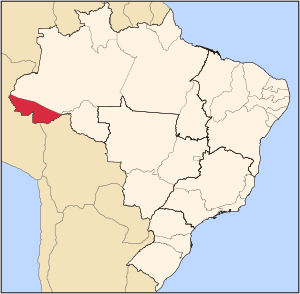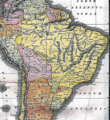Acre (state) facts for kids
Quick facts for kids
State of Acre
|
|||
|---|---|---|---|
|
|||

Location of the State of Acre in Brazil
|
|||
| Country | |||
| Capital | Rio Branco | ||
| Area | |||
| • Total | 152,581 km2 (58,912 sq mi) | ||
| Area rank | 16th | ||
| Population
(2010 census)
|
|||
| • Total | 732,793 | ||
| • Rank | 25th | ||
| • Density | 4.802649/km2 (12.43880/sq mi) | ||
| • Density rank | 23rd | ||
| Demonym(s) | Acriano | ||
| GDP | |||
| • Year | 2006 estimate | ||
| • Total | R$ 4,835,000,000 (26th) | ||
| • Per capita | R$ 7,041 (18th) | ||
| HDI | |||
| • Year | 2005 | ||
| • Category | 0.751 – medium (17th) | ||
| Time zone | UTC-4 (BRT-1) | ||
| Postal Code |
69900-000 to 69999-000
|
||
| ISO 3166 code | BR-AC | ||
Acre is a state located in the Northern Region of Brazil. It is mostly covered by the amazing Amazon Rainforest. This makes Acre a very green and natural place.
Acre shares its borders with two other Brazilian states: Amazonas and Rondônia. It also touches two different countries: Bolivia and Peru.
The capital city of Acre is Rio Branco. Other important cities in the state include Cruzeiro do Sul, Tarauacá, Sena Madureira, and Brasiléia.
Contents
Discovering Acre
Where is Acre?
Acre is found in the western part of Brazil. It's like a corner of the country, bordering both other Brazilian states and neighboring countries. This location makes it a unique place with a mix of cultures and environments.
Nature in Acre
Most of Acre is covered by the vast Amazon Rainforest. This means it has incredible biodiversity, with many different plants and animals. The state is also home to many rivers.
Some of the important rivers flowing through Acre include the Juruá, Purus River, Acre River, Tarauacá, Muru, Embirá, and Xapuri. These rivers are vital for transportation and the local ecosystem.
Acre's Economy
The economy of Acre is mainly based on a few key activities. These include agriculture, which means growing crops. Another important part is cattle animal husbandry, which is raising animals like cows.
Acre is also known for rubber production. Rubber comes from trees and was historically very important for the region's economy.
A Bit of History
For a long time, until the early 20th century, Acre was actually part of Bolivia. However, many Brazilian people had moved to Acre since the 19th century. These Brazilians wanted Acre to be an independent state.
In 1889, Bolivia tried to take full control of the area again. This led to some fights and disagreements.
Finally, on November 17, 1903, Acre officially became a Brazilian territory. Later, on June 15, 1962, it was fully unified and became a state of Brazil, just like it is today.
| States of Brazil | |
|---|---|
| Acre | Alagoas | Amapá | Amazonas | Bahia | Ceará | Espírito Santo | Goiás | Maranhão | Mato Grosso | Mato Grosso do Sul | Minas Gerais | Pará | Paraíba | Paraná | Pernambuco | Piauí | Rio de Janeiro | Rio Grande do Norte | Rio Grande do Sul | Rondônia | Roraima | Santa Catarina | São Paulo | Sergipe | Tocantins | |
| Federal District: Brazilian Federal District | |
Images for kids
-
Map of Brazil during República Velha, 1892. Notice how Acre was not yet part of Brazil.
-
Members of an uncontacted tribe encountered in 2008.
-
Agriculture in Mâncio Lima, Acre, Brazil.
See also
 In Spanish: Acre (Brasil) para niños
In Spanish: Acre (Brasil) para niños
















